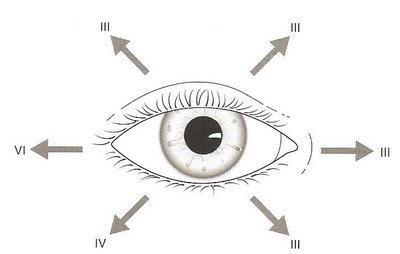Of Winks and Ptosis
Although winks from patients can be rather often especially if you're a pretty girl, remember that the patient may be presented with ptosis ( rather than a mischievous intent). This case would be most likely a spot diagnosis.
Remember, ptosis is defined as drooping of the upper eyelid associated with the inability to elevate the eyelid completely.
Before inspection, be reminded that it would be easier to examine with the patient sitting up rather than lying down. ( Any examination on the head are examined with the patients sitting up anyway) Here's a brief rundown of the anatomy aspect of the possibl ptosis causes.
 Key Points for Inspection:
Key Points for Inspection:- Is the ptosis genuine? ( There could be a pseudoptosis sign where the "ptosis eye" is the normal eye and the seemingly normal eye is abnormal. Deception can be great when panic strikes in short case exams. Usually it can be due to facial nerve palsy, so look for other signs)
- Is it unilateral or bilateral?
- Is the ptosis complete or partial?
- Look at the size of the pupil
- small pupils (miosis) in Horner's syndrome (look for other Horner's sign such as enopthalmos, anhydrosis)
-large pupils (mydriasis) in 3rd nerve palsy which the eye is positioned down and out and failure of reaction in of pupil to light as well as accommodation. - Be sure to rule out other trivial causes although unlikely:
-small eyes (Japanese, Korean, Chinese, etc)
-congenital ptosis
-mechanical ptosis due to edema, mass effect of tumor and scars
-botulism - For Myasthenia Gravis patient, you can try asking the patient to maintain an upward gaze for more than 30 seconds (A gradual lowering of gaze is indicative). Similarly, you can try to elicit the Pick's sign as mentioned by Dekan, although it is very rare.
 The actions of the IIIrd, IVth and VIth nerves on the eye movements of the right eye.
The actions of the IIIrd, IVth and VIth nerves on the eye movements of the right eye.III= Oculomotor, IV=trochlear, VI= abducent
Completion
Say that you would like to take a history from the patient to try to find the cause of their ptosis. (History is still essential anyway, but if your supervisor says otherwise, follow him/her)
There are few common causes of ptosis you must be aware of among the long list of rare ones:
Unilateral:
- 3rd cranial nerve palsy (complete ptosis)
- Horner's syndrome (partial ptosis)
- Syphilis
Bilateral:
-Congenital ptosis
-Myopathies (MG, dystrophia myotonica)
-Syphilis
Take Home Learning Issues:
- State the causes of Horner's syndrome
- Explain the management of Horner's syndrome
- Revise the cranial nerve examination.
0 referrals:
Post a Comment